Research on Urban Forest Park Management Based on Recreation Concept
Abstract
1. Introduction
2. Materials and Methods
2.1. Study Area
2.2. Data Sources
2.3. Study Methods
2.3.1. Quadrat Method
2.3.2. Evaluation Index of Management Status
2.3.3. Single-Factor Analysis
3. Results
3.1. Evaluation of Visual Sensitivity
3.2. Evaluation of Forest Characteristics
3.3. Evaluation of Soil Properties
3.3.1. Soil pH and Moisture Content
3.3.2. Soil-Available Nutrients
3.4. Multi-Level Management of the Park
4. Discussion
4.1. Multi-Functional Forest Management
4.2. Proposals of Management Measure
4.3. Strengths and Weakness
5. Conclusions
Supplementary Materials
Author Contributions
Funding
Data Availability Statement
Acknowledgments
Conflicts of Interest
References
- Yuan, M.; Pan, H.; Shan, Z.; Feng, D. Spatial differences in the effect of communities’ built environment on residents’ health: A case study in Wuhan, China. Int. J. Environ. Res. Public Health 2022, 19, 1392. [Google Scholar] [CrossRef]
- Costanza, R.; Arge, R.; Groo, R.; Farber, S.; Grasso, M.; Hannon, B.; Limburg, K.; Naeem, S.; Neill, R.V.O.; Paruelo, J.; et al. The value of the world’s ecosystem services and natural capital. Ecol. Econ. 1997, 25, 3–15. [Google Scholar] [CrossRef]
- Varela, E.; Jacobsen, J.B.; Mavsar, R. Social demand for multiple benefits provided by Aleppo pine forest management in Catalonia, Spain. Reg. Environ. Chang. 2017, 17, 539–550. [Google Scholar] [CrossRef]
- Qing, L. Effects of forest environment (Shinrin-yoku/Forest bathing) on health promotion and disease prevention—The Establishment of “Forest Medicine”. Environ. Health Prev. Med. 2022, 27, 43. [Google Scholar] [CrossRef]
- Qing, L.; Maiko, K.; Shigeyoshi, K.; Toshiya, O.; Takashi, M.; Takahide, K. Effects of Forest Bathing on Cardiovascular and Metabolic Parameters in Middle-Aged Males. Evid.-Based Complement. Altern. Med. 2016, 2016, 2587381. [Google Scholar] [CrossRef]
- Zhang, Z.; Wang, P.; Gao, Y.; Ye, B. Current development status of forest therapy in China. Healthcare 2020, 8, 61. [Google Scholar] [CrossRef]
- Li, Y.; Han, Q.; Wen, T. Effect of frugality and cognition on forest health tourism intention-A mediating effect analysis based on multigroup comparison. Front. Psychol. 2022, 13, 844628. [Google Scholar] [CrossRef] [PubMed]
- Deng, L.; Li, X.; Luo, H.; Fu, E.K.; Ma, J.; Sun, L.X.; Huang, Z.; Cai, S.Z.; Jia, Y. Empirical study of landscape types, landscape elements and landscape components of the urban park promoting physiological and psychological restoration. Urban For. Urban Green. 2020, 48, 126488. [Google Scholar] [CrossRef]
- He, D.; Chen, K.; Zhang, T.; Yin, M.F.; Shi, X.L.; Xu, Z. Regional CO2 budget and abatement countermeasures for forest scenic spots: A case study of the Shenyang national forest park. Sustainability 2021, 13, 861. [Google Scholar] [CrossRef]
- Yao, X.; Sun, Y.; Sun, B.; Huang, Y. The Impact of the Urban Forest Park Recreation Environment and Perceived Satisfaction on Post-Tour Behavioral Intention—Using Tongzhou Grand Canal Forest Park as an Example. Forests 2024, 15, 330. [Google Scholar] [CrossRef]
- Janeczko, E.; Wójcik, R.; Kędziora, W.; Janeczko, K.; Woznicka, M. Organised physical activity in the forests of the warsaw and tricity agglomerations, Poland. Int. J. Environ. Res. Public Health 2019, 16, 3961. [Google Scholar] [CrossRef]
- Zhao, M.; Zhang, J.; Xie, J.; Zhang, M. Empirical study on recreation suitability evaluation of suburban forest park—A case study of Baiyun forest park in Lishui city, China. Appl. Ecol. Environ. Res. 2019, 17, 3499–3512. [Google Scholar] [CrossRef]
- Chen, B.; Qi, X.; Qiu, Z. Recreational use of urban forest parks: A case study in Fuzhou National Forest Park, China. J. For. Res. 2018, 23, 183–189. [Google Scholar] [CrossRef]
- Cai, M.; Cui, C.; Lin, L.; Di, S.; Zhao, Z.; Wang, Y. Residents’ Spatial Preference for Urban Forest Park Route during Physical Activities. Int. J. Environ. Res. Public Health 2021, 18, 11756. [Google Scholar] [CrossRef] [PubMed]
- Zhu, S.X.; He, S.Y.; Hu, F.F.; Guo, Y.D.; Su, Y.; Cui, G.F.; Li, J.Y.; Qiu, Q.; He, Q. Exurban and suburban forests have superior healthcare benefits beyond downtown forests. Front. Ecol. Evol. 2023, 11, 1105213. [Google Scholar] [CrossRef]
- Min, J.; Pan, T. Landscape evaluation of forest park based on analytic hierarchy process. Math. Probl. Eng. 2022, 2022, 7496570. [Google Scholar] [CrossRef]
- Chan, C.S.; Si, F.H.; Marafa, L.M. Indicator development for sustainable urban park management in Hong Kong. Urban For. Urban Green. 2018, 31, 1–14. [Google Scholar] [CrossRef]
- Pazos-Almada, B.; Bray, D.B. Community-based land sparing: Territorial land-use zoning and forest management in the Sierra Norte of Oaxaca, Mexico. Land Use Policy 2018, 78, 219–226. [Google Scholar] [CrossRef]
- Yeon, P.-S.; Kang, S.-N.; Lee, N.-E.; Kim, I.-O.; Min, G.-M.; Kim, G.-Y.; Kim, J.-G.; Shin, W.-S. Benefits of Urban Forest Healing Program on Depression and Anxiety Symptoms in Depressive Patients. Healthcare 2023, 11, 2766. [Google Scholar] [CrossRef] [PubMed]
- Brang, P.; Spathelf, P.; Larsen, J.B.; Bauhus, J.; Boncìna, A.; Chauvin, C.; Drössler, L.; García-Güemes, C.; Heiri, C.; Kerr, G.; et al. Suitability of close-to-nature silviculture for adapting temperate European forests to climate change. Forestry 2014, 87, 492–503. [Google Scholar] [CrossRef]
- Mattila, O.; Häyrinen, L.; Tervo, M.; Toppinen, A.; Berghäll, S. Challenges of municipal greening and multifunctional forest management: The case of Finland. Urban For. Urban Green. 2015, 14, 982–990. [Google Scholar] [CrossRef]
- Huang, X.; Teng, M.; Zhou, Z.; Wang, P.C.; Dian, Y.Y.; Wu, C.G. Linking naturalness and quality improvement of monoculture plantations in urban area: A case study in Wuhan city, China. Urban For. Urban Green. 2021, 59, 126911. [Google Scholar] [CrossRef]
- Borrass, L.; Kleinschmit, D.; Winkel, G. The “German model” of integrative multifunctional forest management—Analysing the emergence and political evolution of a forest management concept. For. Policy. Econ. 2017, 77, 16–23. [Google Scholar] [CrossRef]
- Pukkala, T. Which type of forest management provides most ecosystem services? For. Ecosyst. 2016, 3, 9. [Google Scholar] [CrossRef]
- Krcmar, E.; Vertinsky, I.; Van Kooten, G.C. Modeling alternative zoning strategies in forest management. Int. Trans. Oper. Res. 2003, 10, 483–498. [Google Scholar] [CrossRef]
- Hansmann, R.; Kilchling, P.; Seeland, K. The effects of regional forest owner organizations on forest management in the Swiss Canton of Lucerne. Small-Scale For. 2016, 15, 159–177. [Google Scholar] [CrossRef]
- Stevens, J.A.; Montgomery, C.A. Understanding the Compatibility of Multiple Uses on Forest Land: A Survey of Multiresource Research with Application to the Pacific Northwest; General Technical Reports; U.S. Department of Agriculture, Forest Service: Fort Collins, CO, USA, 2002; p. PNW-GTR-539. [Google Scholar]
- Zhang, G.S.; Leclerc, M.Y.; Duarte, H.F.; Durden, D.; Werth, D.; Kurzeja, R.; Parker, M. Multi-scale decomposition of turbulent fluxes above a forest canopy. Agric. For. Meteorol. 2014, 186, 48–63. [Google Scholar] [CrossRef]
- Min, Z.; Wu, B.; Su, X.; Chen, Y.L.; Tian, Y.Z. Suitability evaluation and dominant function model for multifunctional forest management. Forests 2020, 11, 1368. [Google Scholar] [CrossRef]
- Yeon, P.S.; Kim, I.O.; Kang, S.N.; Lee, N.E.; Kim, G.Y.; Shim, H.R.; Chung, C.Y.; Lee, J.S.; Jeon, J.Y.; Shin, W.S. Effects of Mobile-Based Forest-Therapy Programs Using Urban Forests for Symptoms of Depressed Patients. Healthcare 2023, 11, 3039. [Google Scholar] [CrossRef]
- Gong, L.; Zhang, Z.; Xu, C. Developing a quality assessment index system for scenic forest management: A case study from Xishan Mountain, Suburban Beijing. Forests 2015, 6, 225–243. [Google Scholar] [CrossRef]
- Navalho, I.; Alegria, C.; Roque, N.; Quinta-Nova, L. Mapping forest landscape multifunctionality using multicriteria spatial analysis. Floresta Ambient. 2019, 26, e20170702. [Google Scholar] [CrossRef]
- Standovár, T.; Szmorad, F.; Kovács, B.; Kelemen, K.; Plattner, M.; Roth, T.; Pataki, Z. A novel forest state assessment methodology to support conservation and forest management planning. Community Ecol. 2016, 17, 167–177. [Google Scholar] [CrossRef]
- Gurnell, J.; Clark, M.J.; Lurz, P.W.W.; Shirley, M.D.F.; Rushton, S.P. Conserving red squirrels (Sciurus vulgaris): Mapping and forecasting habitat suitability using a Geographic Information Systems Approach. Biol. Conserv. 2002, 105, 53–64. [Google Scholar] [CrossRef]
- Kim, H.R.; Kim, J.S.; Jo, J.Y.; Shin, W.S. Analysis of Perceived Restorativeness, Restoration Outcomes, and Plant Preference of Garden Visitors: Focusing on National Gardens, Local Gardens, and Private Gardens. J. People Plants Environ. 2023, 4, 379–401. [Google Scholar] [CrossRef]
- Beguet, B.; Guyon, D.; Boukir, S.; Chehata, N. Automated retrieval of forest structure variables based on multi-scale texture analysis of VHR satellite imagery. Isprs. J. Photogramm. 2014, 96, 164–178. [Google Scholar] [CrossRef]
- Bieling, C. Non-industrial private-forest owners: Possibilities for increasing adoption of close-to-nature forest management. Eur. J. Forest. Res. 2004, 123, 293–303. [Google Scholar] [CrossRef]
- Cubbage, F.; Harou, P.; Sills, E. Policy instruments to enhance multi-functional forest management. For. Policy Econ. 2007, 9, 833–851. [Google Scholar] [CrossRef]
- Leban, V.; Malovrh, Š.P.; Stirn, L.Z.; Krč, J. Forest biomass for energy in multi-functional forest management: Insight into the perceptions of forest-related professionals. For. Policy Econ. 2016, 71, 87–93. [Google Scholar] [CrossRef]
- Wu, X.X.; Gu, Z.J. Contribution weight of forest canopy and grass layers to soil and water conservation on water-eroded areas in southern China. Eurasian Soil Sc. 2020, 53, 1004–1012. [Google Scholar] [CrossRef]
- Zhang, Y.Q. Multiple-use forestry vs. forestland-use specialization revisited. For. Policy Econ. 2005, 7, 143–156. [Google Scholar] [CrossRef]
- Han, X.; Sun, T.; Cao, T. Study on landscape quality assessment of urban forest parks: Take Nanjing Zijinshan National Forest Park as an example. Ecol. Indic. 2021, 120, 106902. [Google Scholar] [CrossRef]
- Store, R.; Karjalainen, E.; Haara, A.; Leskinen, P.; Nivala, V. Producing a sensitivity assessment method for visual forest landscapes. Landsc. Urban Plan. 2015, 144, 128–141. [Google Scholar] [CrossRef]
- Yang, H.J.; Li, Y.N.; Zhang, Z.D.; Xu, Z.Q.; Huang, X.R. GIS-based multi-criteria assessment and seasonal impact on plantation forest landscape visual sensitivity. Forests 2019, 10, 297. [Google Scholar] [CrossRef]
- De Meo, I.; Cantiani, P.; Paletto, A. Effect of thinning on forest scenic beauty in a black pine forest in central Italy. Forests 2020, 11, 1295. [Google Scholar] [CrossRef]
- Tan, X.H.; Peng, Y.L. Scenic beauty evaluation of plant landscape in Yunlong Lake wetland park of Xuzhou City, China. Arab. J. Geosci. 2020, 13, 701. [Google Scholar] [CrossRef]
- Tenerelli, P.; Püffel, C.; Luque, S. Spatial assessment of aesthetic services in a complex mountain region: Combining visual landscape properties with crowdsourced geographic information. Landsc. Ecol. 2017, 32, 1097–1115. [Google Scholar] [CrossRef]
- Mundher, R.; Abu Bakar, S.; Maulan, S.; Yusof, M.J.M.; Al-Sharaa, A.; Aziz, A.; Gao, H.Y. Aesthetic quality assessment of landscapes as a model for urban forest areas: A systematic literature review. Forests 2022, 13, 991. [Google Scholar] [CrossRef]
- Zheng, Y.; Lan, S.R.; Chen, W.Y.; Chen, X.Y.; Xu, X.X.; Chen, Y.N.; Dong, J.W. Visual sensitivity versus ecological sensitivity: An application of GIS in urban forest park planning. Urban For. Urban Green. 2019, 41, 139–149. [Google Scholar] [CrossRef]
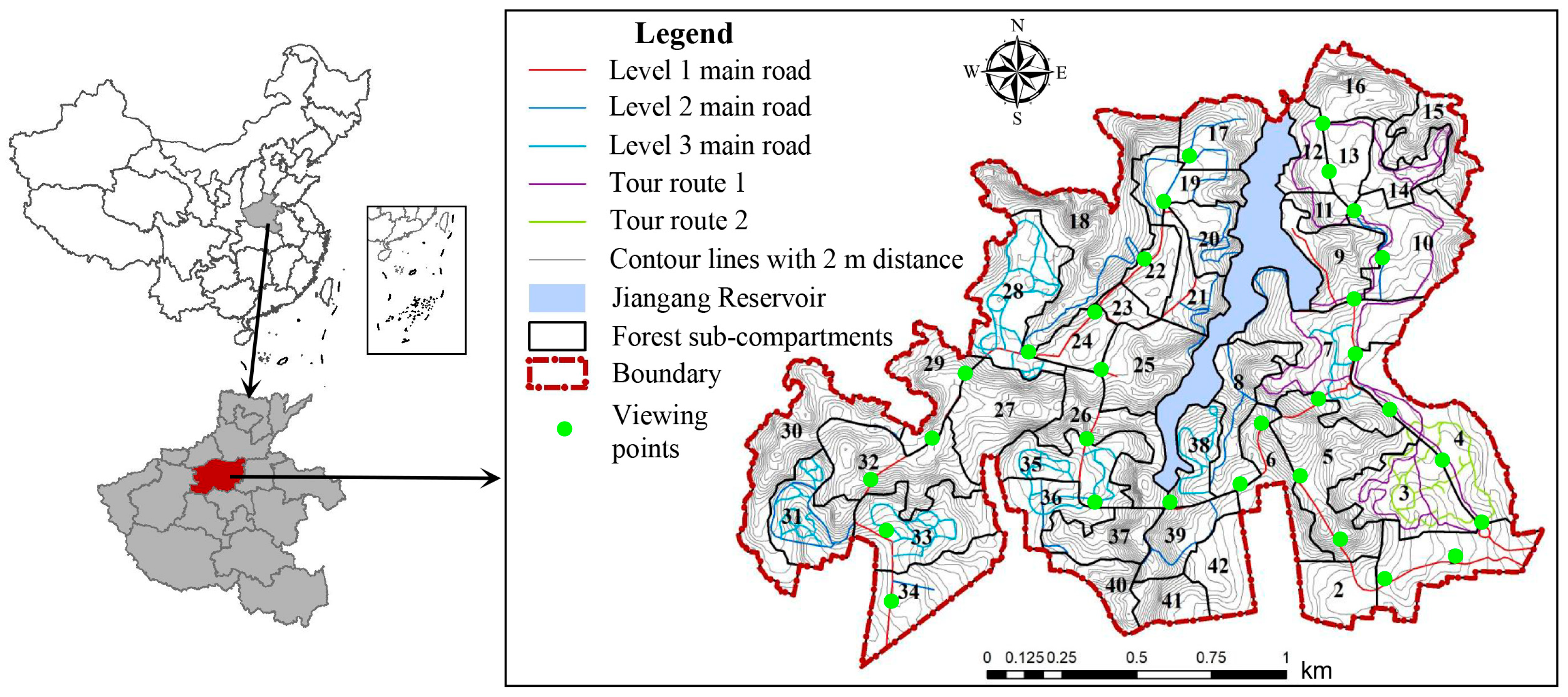
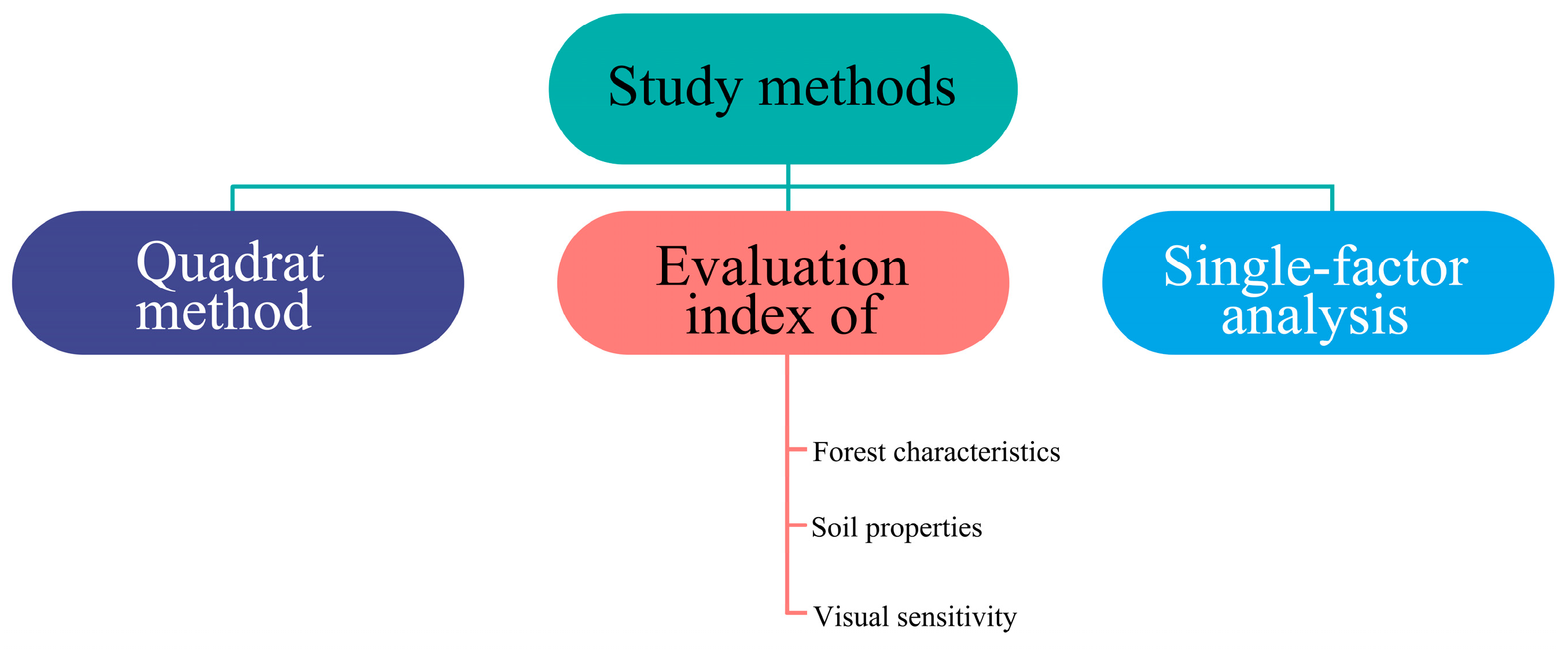



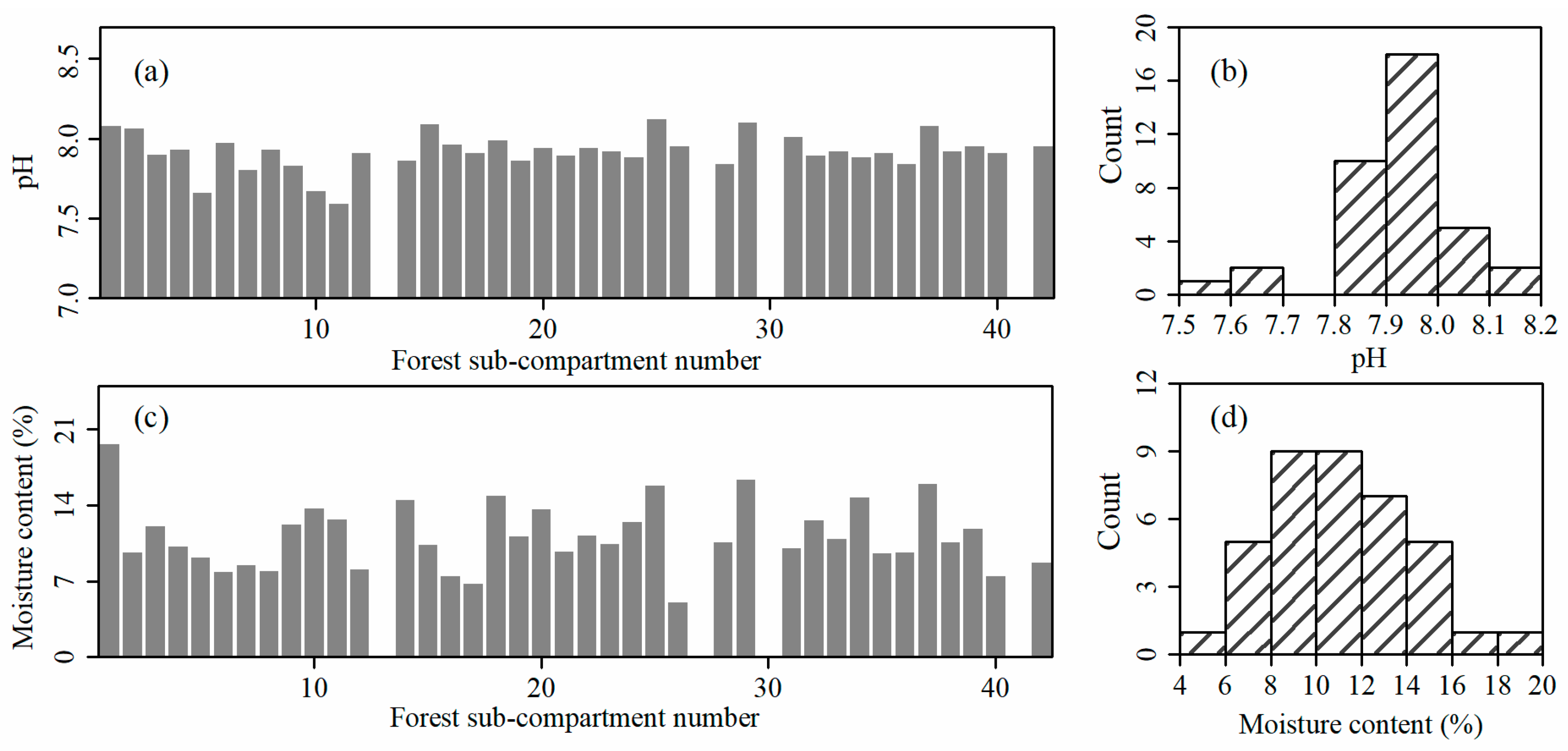
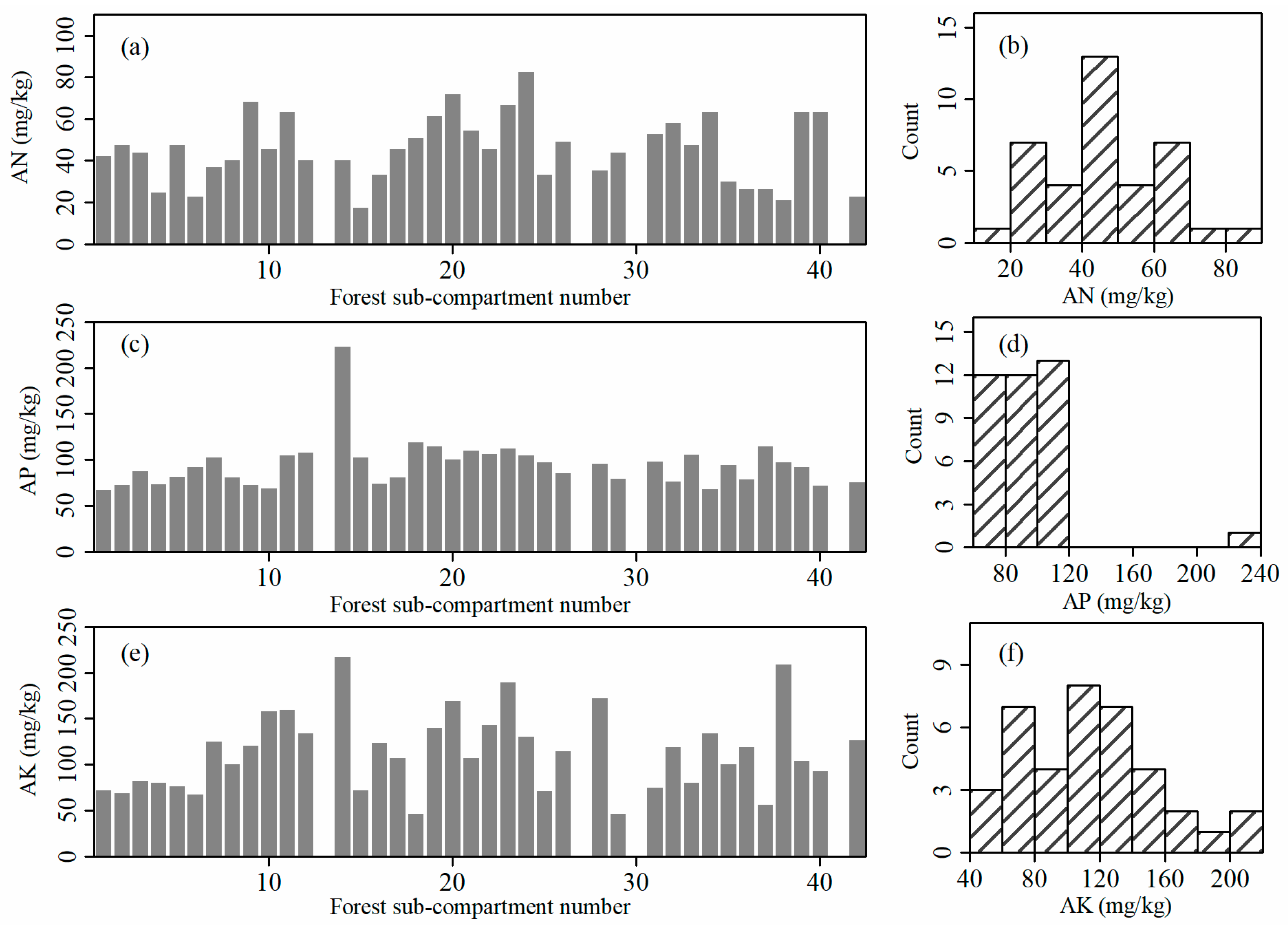
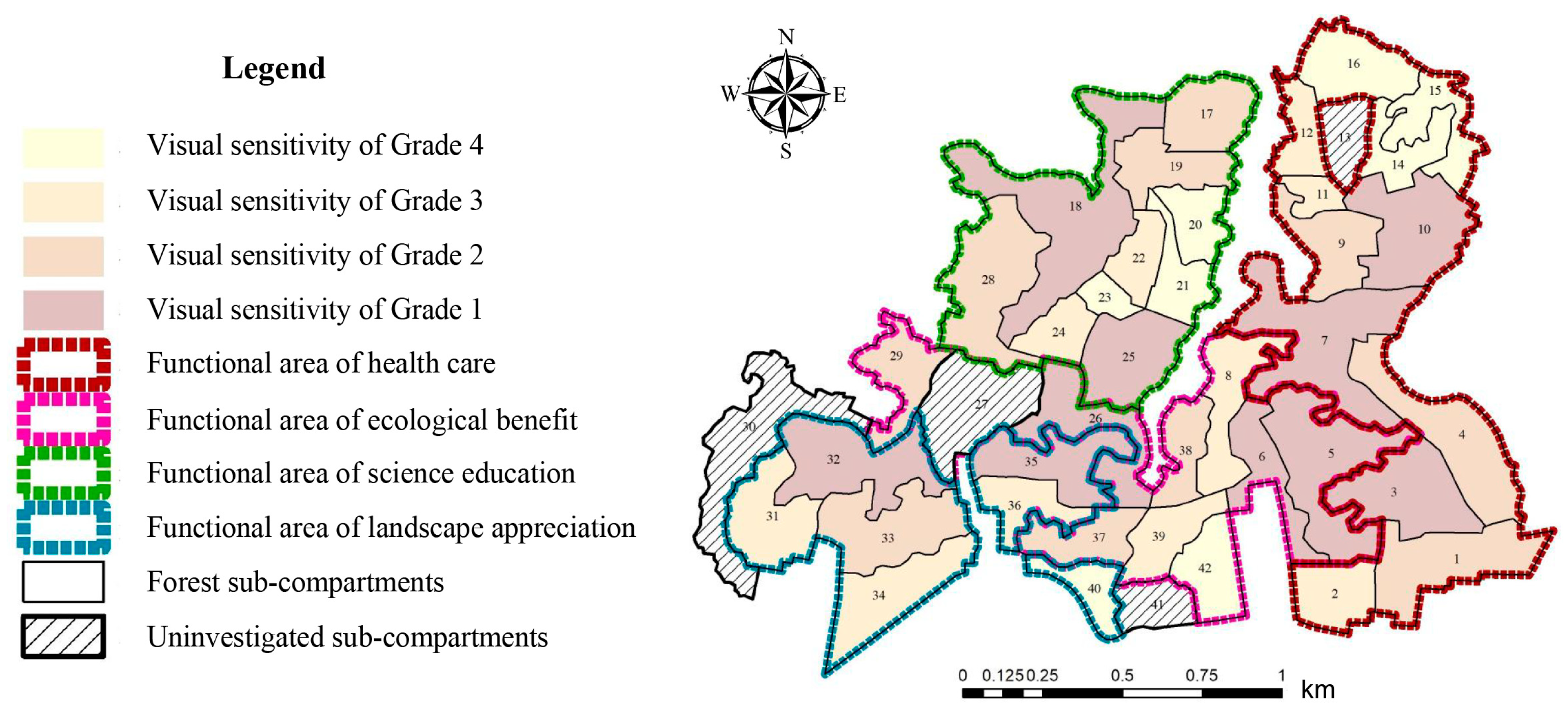
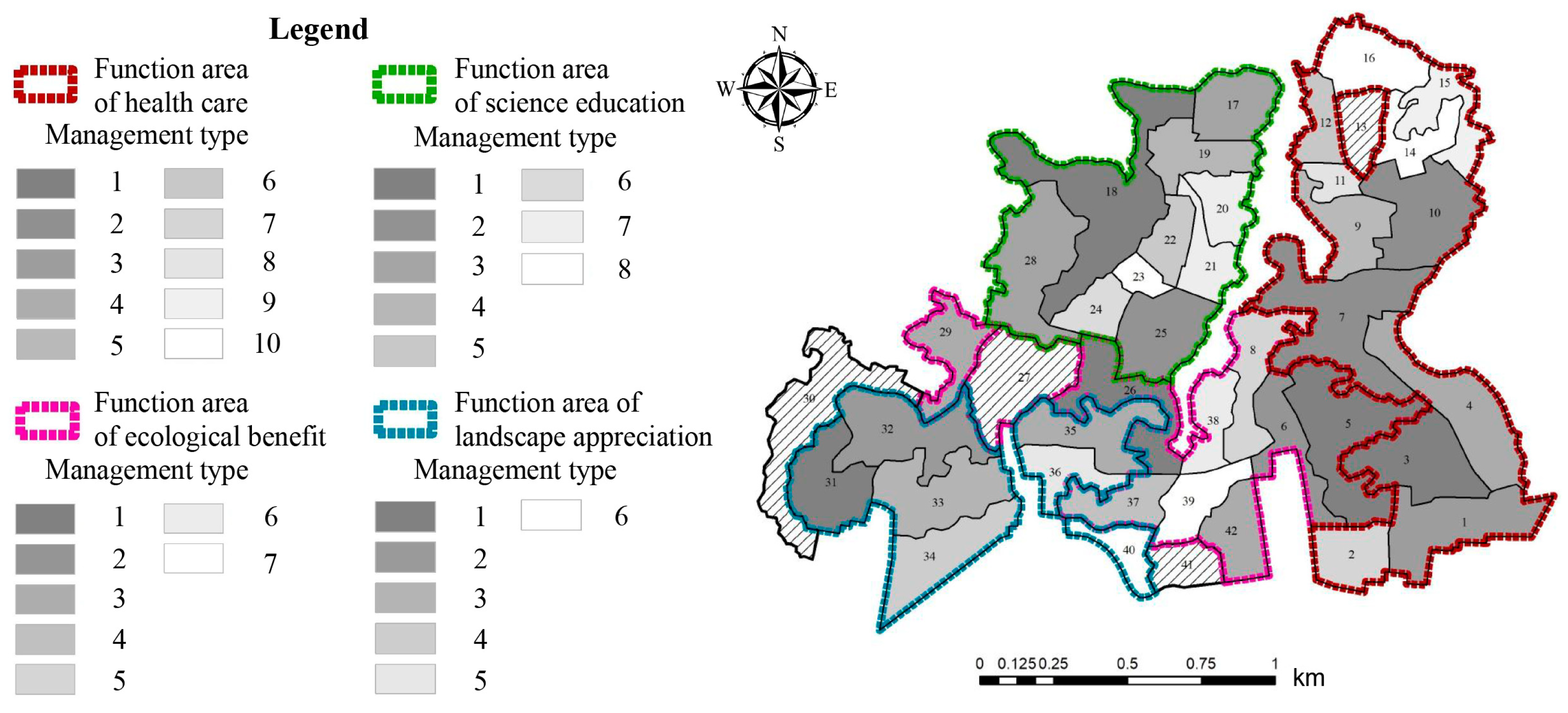
| Index (/Unit) | Benchmark Value | Meaning | Weight |
|---|---|---|---|
| Canopy density | 0.70 | Sustainability requirements | 0.326 |
| Mean DBH/cm | 13.60 | Mean value of the eighth National Forest Resources Inventory | 0.099 |
| Mean tree height/m | 22.71 | Mean value of forest subcompartments | 0.099 |
| Mean under-branch height/m | 2.50 | Comfort requirements of body space | 0.099 |
| Arbor density of stand/plant·hectare−1 | 1584 | Mean value of forest subcompartments | 0.189 |
| Age class of forest | Mature forests | Scenic beauty development requirements of the landscape | 0.189 |
| Level 1 Index | Weight | Level 2 Index | Weight | Proportion of Visual Field % | Assignment |
|---|---|---|---|---|---|
| Visual probability | 0.80 | 0–250 m | 0.54 | ≥66.79 | 7 |
| 46.70–66.79 | 5 | ||||
| 29.48–46.70 | 3 | ||||
| ≤29.48 | 1 | ||||
| 250–500 m | 0.30 | ≥71.00 | 7 | ||
| 49.09–71.00 | 5 | ||||
| 28.18–49.09 | 3 | ||||
| ≤28.18 | 1 | ||||
| 500–1000 m | 0.16 | ≥58.50 | 7 | ||
| 38.74–58.50 | 5 | ||||
| 23.58–36.93 | 3 | ||||
| ≤23.58 | 1 |
| Grade | Weight | Evaluation Standard | Assignment |
|---|---|---|---|
| Relative slope | 0.20 | ≥15.96 | 7 |
| 9.71–15.96 | 5 | ||
| 4.79–9.71 | 3 | ||
| ≤4.79 | 1 |
| Function Area | Facility | Advantage | Disadvantage |
|---|---|---|---|
| Healthcare area | leisure and entertainment facilities, basketball court, fitness field | large flow of people | lack of natural education facilities |
| Ecological benefit area | less facilities | more forest types | lack of infrastructure |
| Science and education area | supporting education facilities | rich plant resources | lack of natural resources facilities |
| Landscape appreciation area | security facilities | to meet the needs of tourism | the lack of natural education facilities |
Disclaimer/Publisher’s Note: The statements, opinions and data contained in all publications are solely those of the individual author(s) and contributor(s) and not of MDPI and/or the editor(s). MDPI and/or the editor(s) disclaim responsibility for any injury to people or property resulting from any ideas, methods, instructions or products referred to in the content. |
© 2025 by the authors. Licensee MDPI, Basel, Switzerland. This article is an open access article distributed under the terms and conditions of the Creative Commons Attribution (CC BY) license (https://creativecommons.org/licenses/by/4.0/).
Share and Cite
Li, X.; Chen, M.; Qin, Y.; Yang, Y.; Liao, X.; Gao, C.; Zhao, J.; Huang, X.; Li, Z. Research on Urban Forest Park Management Based on Recreation Concept. Forests 2025, 16, 102. https://doi.org/10.3390/f16010102
Li X, Chen M, Qin Y, Yang Y, Liao X, Gao C, Zhao J, Huang X, Li Z. Research on Urban Forest Park Management Based on Recreation Concept. Forests. 2025; 16(1):102. https://doi.org/10.3390/f16010102
Chicago/Turabian StyleLi, Ximei, Mingzhu Chen, Yi Qin, Yi Yang, Xiaoyu Liao, Chunyu Gao, Junjing Zhao, Xin Huang, and Zhi Li. 2025. "Research on Urban Forest Park Management Based on Recreation Concept" Forests 16, no. 1: 102. https://doi.org/10.3390/f16010102
APA StyleLi, X., Chen, M., Qin, Y., Yang, Y., Liao, X., Gao, C., Zhao, J., Huang, X., & Li, Z. (2025). Research on Urban Forest Park Management Based on Recreation Concept. Forests, 16(1), 102. https://doi.org/10.3390/f16010102








